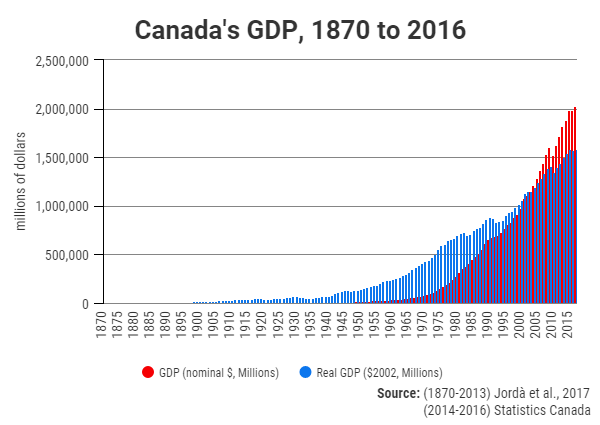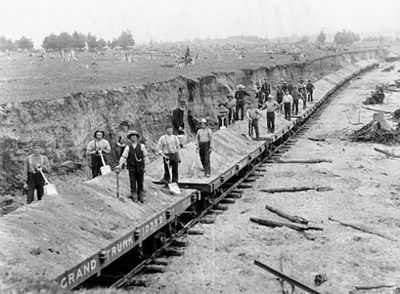A recession can mean “going down.” The word “recession” is often used when talking about the economy. An economic recession is a time when the economy is going down. Production goes down. Spending goes down. Stock markets go down. Overall, the gross domestic product (GDP) goes down. GDP is the amount of goods and services produced in a country. A recession happens when the economy goes down for more than a few months. Recessions occur often, and they cause many problems for individuals and businesses.
This article is a plain-language summary of Recession in Canada. If you are interested in reading about this topic in more depth, please see our full-length entry, Recession in Canada.
Business Cycles
Recessions are part of business cycles. Business cycle is a term used to describe the ups and downs of the economy. Business cycles go up and down all the time. They never stay the same. Recessions start when the business cycle is at the top. They end when the business cycle is at its lowest. Business cycles go down for many reasons. They can go down because of high prices. They can go down when people stop making as much money as they used to make. And they can go down because people think the economy may be going bad.
How Businesses Respond to Recessions
Recessions can have positive outcomes for businesses. They can force businesses to change. For instance, they can make businesses make better goods. They can make businesses think about other places where they can sell their products. They can also make small companies develop and grow.
Government Response to Recession
Governments try to limit recessions and end them quickly. They do this in many ways. For example, they lower interest rates. And they put more money into the economy (see Monetary Policy). Governments do this to try to get people to spend more money. They believe that if more people spend more money, there will be more business. If there is more business, there will be more jobs. And if there are more jobs, more people will have more money to spend. This will further increase business. So, the government can spend more money to create more jobs.
History of Recessions in Canada
Canada has had many recessions. Since 1929 it has had 12 recessions. Since 1970 there have been five recessions. Most recessions do not last very long. The average recession lasts between three and nine months. The latest recession happened in early 2020 because of the COVID-19 pandemic. It only lasted a few months and has been described as the shortest but deepest recession since 1929. Before that, Canada had a recession from between 2008 and 2009 (see Recession of 2008-09 in Canada). It lasted for seven months. Usually, when the United States has a recession, so does Canada. The Canadian economy is linked to the American economy. (See also Canada-US Economic Relations.)
2008-09 Global Financial Crisis and Recession
The recession of 2008-09 in Canada happened because of economic problems in the United States. The American economy went down because there was a housing crisis. Many Americans could not afford to pay for their houses anymore. So, the housing market crashed. Banks and lending institutions suffered. Some of them failed. As a result, many Americans became scared for the future. People stopped spending as much money as they used to spend. And banks stopped lending as much money as they had in the recent past when the housing market boomed.
The GDP in Canada went down by 3.3 percent during the recession of 2008-09. A big reason why it declined is Canada stopped exporting as much as it had before (see Exports from Canada). The economy began to recover after the government began to stimulate it. It did so by putting more money into the economy and lowering interest rates (see Monetary Policy).
Recession vs. Depression
A depression lasts longer than a recession. Depressions are longer than one year. During a depression there is a lot of unemployment. Also, prices fall, people make less money than before, and there is a lot of fear about the future of the economy. The worst depression in Canadian history is called the Great Depression. It lasted from 1929 until 1939.

 Share on Facebook
Share on Facebook Share on X
Share on X Share by Email
Share by Email Share on Google Classroom
Share on Google Classroom















